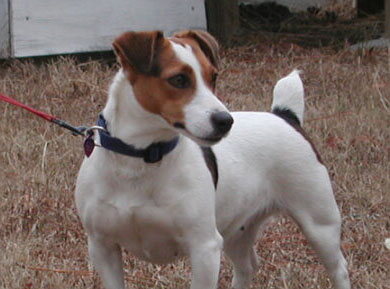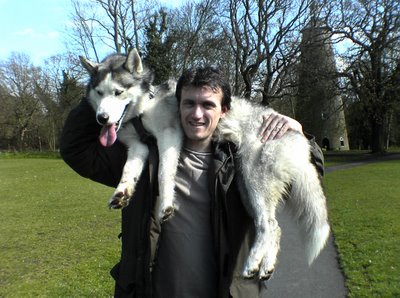Introducing a puppy to a cat
I have been asked on my Youtube space about introducing a husky puppy to a cat, so I thought I'd blog about it to give me a bit more freedom than the Youtube comment limit allows. Firstly, there are some great online resources, such as these that I found very quickly on Google:
We introduced Lupus (the dog) to our home when Oliver (the cat) was approximately 5 years old. Puppies are very curious and also very boistrous, which doesn't go down too well with a well established cat, so we introduced them as carefully as possible.
Oliver hid for a few days, but by careful mnagement regained his normal routine pretty quickly.
Separation
We 'cage (or 'crate') trained' Lupus, in that he had his own cage in the house that was his space. It contained his bed, his food, his water and one or two of his toys (you shouldn't give a dog all his toys, as they should belong to you and not the dog, so you give him a toy as a reward!). Anyway, this worked very well, as the dog had a space where he could be kept while we were in bed or out for short periods (after gradual training) and that he could retreat to when he needed to feel safe. This allowed the rest of the flat to remain the primary territory of the cat, avoiding conflicts of that nature.
I strongly recommend getting a cage for the dog, providing it's large enough (ours was huge), as it's not at all cruel. Dogs need a 'den' where they can sleep and feel safe, a place to call their own, even if it's just for the first year until they're fully house trained and they can find their own place in the home. Huskies can be very destructive, loving to steal things and stress test them with their teeth (otherwise known as 'chewing'), so a cage is a good way of preventing accidents.
Speaking of accidents, confining a puppy's 'toilet mess' to a cage during the night will also make cleaning much easier, and will help with the house training. It's much easier and more hygenic than getting it out of your carpets, which will happen, but not as often!
Pecking Order
As dogs have a strong recognition of social pecking order we made sure that the dog wasn't 'promoted' above the cat, even though it doesn't mean much to the cat itself. Huskies have a strong pack instinct and will try to advance to the 'alpha' pack position from an early age, so ensuring that a dogs position is constantly communicated is important.
This just involved simple things like ensuring the cat was fed before the dog (and that the dog realised this), so we established the feeding order accordingly:
- Us (the 'alpha' pair)
- The cat
- The dog
Behavioural Changes
We did notice behavioural changes in Oliver. He went from being quite dismissive to being more affectionate, as he competed for attention with the dog. When you get a cute new puppy it's easy to neglect the cat, so we made sure that he got plenty of attention.
By making the dog sleep in his cage every night, the cat had the freedom to sleep with us without fear of 'puppy ambush' and get plenty of affection, so we established a routine around this.
Time
The main thing we've learnt is that the dog and cat will sort themselves out over time, gradually learning about each other and learning to live together. The cat still has an occasional swipe at the dog, but the dog has leaned not to stick his nose in the cat's face.
Saying that, hold a piece of chicken in front of them and they'll sit together like best friends, so no matter what their brains say their stomachs have overall control!
Labels: cat, husky, introducing, introducing husky cat separation time territory behaviour, separation, territory, time


